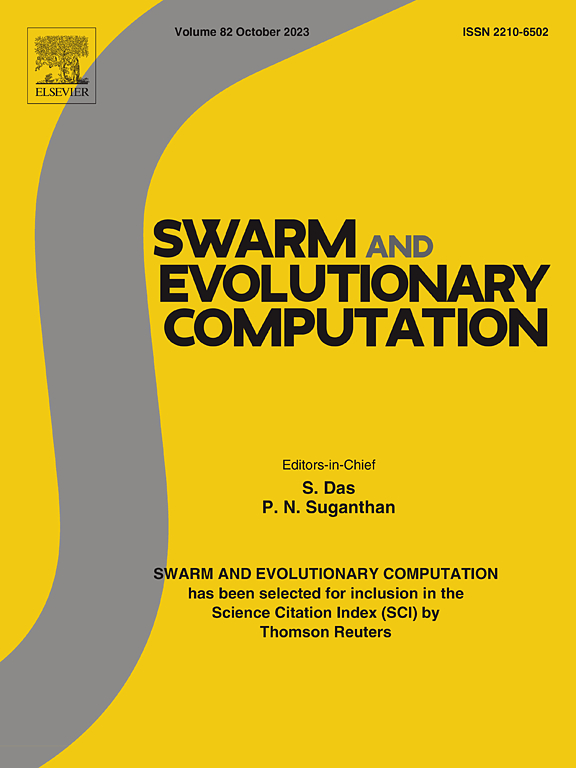不同轨道对准下列车节能速度线生成:余弦退火的量子进化算法
IF 8.5
1区 计算机科学
Q1 COMPUTER SCIENCE, ARTIFICIAL INTELLIGENCE
引用次数: 0
摘要
列车速度分布优化是降低城市轨道交通能耗和运营成本的有效手段。近年来,许多智能优化算法被用于生成高质量的速度轮廓优化模型解。然而,以往的研究大多预设了列车运行顺序,忽略了轨道线形多样性对列车运行方式的复杂影响。这一限制阻碍了这些发现在轨道交通网络内多个站间的适用性。此外,所提出的优化算法在不同列车运行场景下的验证还不够充分。本研究将列车速度剖面的生成重新表述为连续速度空间内的多阶段决策问题。运用能量守恒定律,建立了列车运行过程的动力学模型,将列车运行速度的决策演化映射到高维量子空间中。随后,利用余弦退火函数(CA-QEA)设计了一种自适应旋转策略的改进量子进化算法。在此基础上,引入了条件量子坍缩机制,增强了算法的全局搜索能力。利用中国天津的实际轨道交通数据,构建了三个不同轨道路线的测试场景,包括缓坡、节能坡和多个连续陡坡。结果表明,该方法能有效降低三种不同轨道对中牵引能耗(TEC)。Friedman非参数测试结果表明,CA-QEA的性能优于几种成熟的智能优化算法。本文章由计算机程序翻译,如有差异,请以英文原文为准。
Train energy-efficient speed profile generation under various track alignments: a quantum evolutionary algorithm with cosine annealing
The optimization of train speed profiles is an effective method for reducing energy consumption and operating costs for urban rail transit (URT). In recent years, numerous intelligent optimization algorithms have been employed to generate high-quality solutions for speed profile optimization models. However, most previous studies preset the train operation sequence, overlooking the complex impacts of track alignment diversity on train operation modes. This limitation hinders the applicability of these findings across multiple inter-stations within the URT network. Moreover, there has been insufficient validation of the proposed optimization algorithms under diverse train operation scenarios. This study reformulates the generation of train speed profiles as a multi-stage decision-making problem within a continuous speed space. By applying the law of conservation of energy, a dynamic model of the train operation process is established and the decision evolution of the train speed is mapped into a high-dimensional quantum space. Subsequently, an improved quantum evolutionary algorithm with adaptive rotation strategies is designed using the cosine annealing function (CA-QEA). Furthermore, a conditional quantum collapse mechanism is introduced to enhance the global search capability of the algorithm. Utilizing actual URT data from Tianjin, China, three test scenarios featuring various track alignments, including gentle slopes, energy-saving slopes, and multiple continuous steep slopes, are constructed. The results demonstrate that the proposed method can effectively reduce the traction energy consumption (TEC) in three different track alignment. The Friedman non-parametric test results indicate that the performance of CA-QEA surpasses that of several mature intelligent optimization algorithms.
求助全文
通过发布文献求助,成功后即可免费获取论文全文。
去求助
来源期刊

Swarm and Evolutionary Computation
COMPUTER SCIENCE, ARTIFICIAL INTELLIGENCEC-COMPUTER SCIENCE, THEORY & METHODS
CiteScore
16.00
自引率
12.00%
发文量
169
期刊介绍:
Swarm and Evolutionary Computation is a pioneering peer-reviewed journal focused on the latest research and advancements in nature-inspired intelligent computation using swarm and evolutionary algorithms. It covers theoretical, experimental, and practical aspects of these paradigms and their hybrids, promoting interdisciplinary research. The journal prioritizes the publication of high-quality, original articles that push the boundaries of evolutionary computation and swarm intelligence. Additionally, it welcomes survey papers on current topics and novel applications. Topics of interest include but are not limited to: Genetic Algorithms, and Genetic Programming, Evolution Strategies, and Evolutionary Programming, Differential Evolution, Artificial Immune Systems, Particle Swarms, Ant Colony, Bacterial Foraging, Artificial Bees, Fireflies Algorithm, Harmony Search, Artificial Life, Digital Organisms, Estimation of Distribution Algorithms, Stochastic Diffusion Search, Quantum Computing, Nano Computing, Membrane Computing, Human-centric Computing, Hybridization of Algorithms, Memetic Computing, Autonomic Computing, Self-organizing systems, Combinatorial, Discrete, Binary, Constrained, Multi-objective, Multi-modal, Dynamic, and Large-scale Optimization.
 求助内容:
求助内容: 应助结果提醒方式:
应助结果提醒方式:


